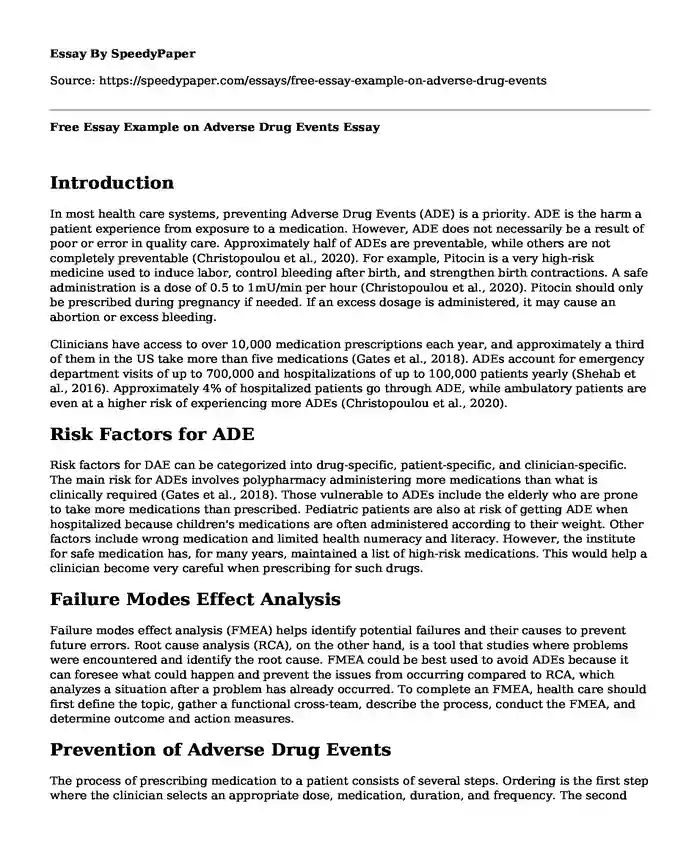
| Type of paper: | Essay |
| Categories: | Healthcare Drug |
| Pages: | 3 |
| Wordcount: | 744 words |
Introduction
In most health care systems, preventing Adverse Drug Events (ADE) is a priority. ADE is the harm a patient experience from exposure to a medication. However, ADE does not necessarily be a result of poor or error in quality care. Approximately half of ADEs are preventable, while others are not completely preventable (Christopoulou et al., 2020). For example, Pitocin is a very high-risk medicine used to induce labor, control bleeding after birth, and strengthen birth contractions. A safe administration is a dose of 0.5 to 1mU/min per hour (Christopoulou et al., 2020). Pitocin should only be prescribed during pregnancy if needed. If an excess dosage is administered, it may cause an abortion or excess bleeding.
Clinicians have access to over 10,000 medication prescriptions each year, and approximately a third of them in the US take more than five medications (Gates et al., 2018). ADEs account for emergency department visits of up to 700,000 and hospitalizations of up to 100,000 patients yearly (Shehab et al., 2016). Approximately 4% of hospitalized patients go through ADE, while ambulatory patients are even at a higher risk of experiencing more ADEs (Christopoulou et al., 2020).
Risk Factors for ADE
Risk factors for DAE can be categorized into drug-specific, patient-specific, and clinician-specific. The main risk for ADEs involves polypharmacy administering more medications than what is clinically required (Gates et al., 2018). Those vulnerable to ADEs include the elderly who are prone to take more medications than prescribed. Pediatric patients are also at risk of getting ADE when hospitalized because children's medications are often administered according to their weight. Other factors include wrong medication and limited health numeracy and literacy. However, the institute for safe medication has, for many years, maintained a list of high-risk medications. This would help a clinician become very careful when prescribing for such drugs.
Failure Modes Effect Analysis
Failure modes effect analysis (FMEA) helps identify potential failures and their causes to prevent future errors. Root cause analysis (RCA), on the other hand, is a tool that studies where problems were encountered and identify the root cause. FMEA could be best used to avoid ADEs because it can foresee what could happen and prevent the issues from occurring compared to RCA, which analyzes a situation after a problem has already occurred. To complete an FMEA, health care should first define the topic, gather a functional cross-team, describe the process, conduct the FMEA, and determine outcome and action measures.
Prevention of Adverse Drug Events
The process of prescribing medication to a patient consists of several steps. Ordering is the first step where the clinician selects an appropriate dose, medication, duration, and frequency. The second step is transcribing, where the patient reads and interprets the prescription in a paper-based system. Another step is dispensing, which involves the pharmacist checking for the drug to drug allergies and interactions and then releasing the correct form with an appropriate medicine quantity. The last step is an administration where the correct medication is given at the right time to the correct patient.
Preventing medication errors in each stage would help prevent adverse drug events (Shehab et al., 2016). Some of these strategies include prescribing, order entry should be computerized with clinical support decision systems, unnecessary medications should be avoided, and conservative principles of prescribing should be adhered to, and during care transition, there should be medication reconciliation. In transcribing, order entry should also be computerized to prevent handwriting errors.
Conclusion
Thus, at the dispensing stage, the clinicians should oversee the dispensing medication process, the high-risk medication should use automated dispensing cabinets, and the five rights of medication safety (administering the right medication, to the right patient, at the right time, in the right dose, and by the right way) should be adhered to. Finally, in the administration stage, interruptions should be minimized for safe medication, and there should be patient education that will improve patient comprehension on the administration of the medicine.
Reference
Christopoulou, F., Tran, T. T., Sahu, S. K., Miwa, M., & Ananiadou, S. (2020). Adverse drug events and medication relation extraction in electronic health records with ensemble deep learning methods. Journal of the American Medical Informatics Association, 27(1), 39-46.
Gates, P. J., Meyerson, S. A., Baysari, M. T., Lehmann, C. U., & Westbrook, J. I. (2018). Preventable adverse drug events among inpatients: a systematic review. Pediatrics, 142(3), e20180805.
Shehab, N., Lovegrove, M. C., Geller, A. I., Rose, K. O., Weidle, N. J., & Budnitz, D. S. (2016). US emergency department visits for outpatient adverse drug events, 2013-2014. Jama, 316(20), 2115-2125.
Cite this page
Free Essay Example on Adverse Drug Events. (2023, Nov 24). Retrieved from https://speedypaper.net/essays/free-essay-example-on-adverse-drug-events
Request Removal
If you are the original author of this essay and no longer wish to have it published on the SpeedyPaper website, please click below to request its removal:
- Nutritionist Advice - Free Essay Sample
- Manic Depression and Anxiety in Teens, Free Essay in Psychology
- Free Essay Sample: Human Resource Issues.
- Essay Sample on Ripple Effect from COVID-19 on Global Energy
- Essay on Prenatal Exposure to Teratogens: Impacts on Fetal Development and Long-Term Effects
- Should States Be Allowed to Make Drug Laws? Paper Example
- Planned Parenthood v. Casey: Navigating Abortion Rights and State Regulations in the U.S.
Popular categories




